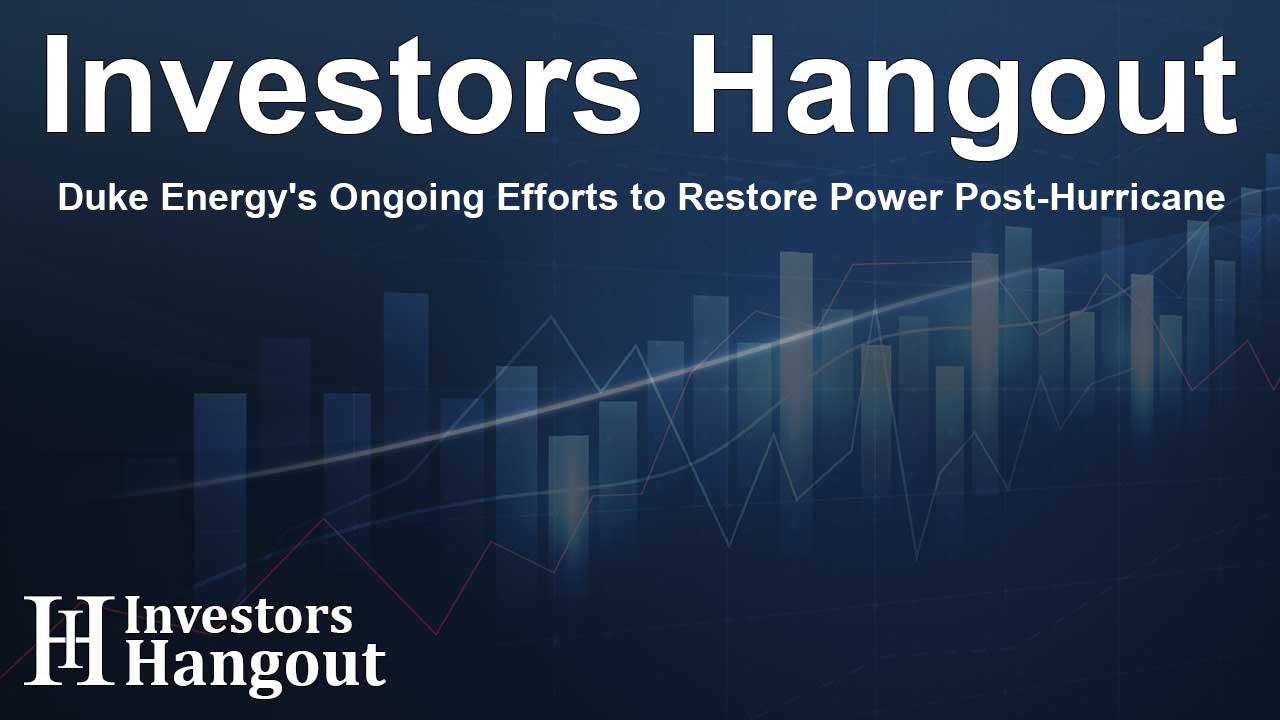Duke Energy's Ongoing Efforts to Restore Power Post-Hurricane

Duke Energy's Restoration Progress After Hurricane Helene
Following the devastation caused by Hurricane Helene, Duke Energy has restored power to more than 2.16 million customers across the Carolinas. Just recently, approximately 85,000 customers regained their service, showcasing the dedication of Duke Energy's restoration teams.
Current Power Outages and Efforts
Despite the remarkable restoration efforts, there remain about 334,000 customers still without power, particularly in certain regions of South Carolina and North Carolina. It’s important to note that some customers may not regain power due to the severe damage or destruction of their homes or businesses.
Utilizing Technology for Damage Assessment
In an effort to enhance the restoration process, Duke Energy is employing advanced technologies, such as drones and helicopters. These tools are invaluable for inspecting hard-to-reach areas and assessing any additional damage that may have occurred, ensuring that restoration efforts are as thorough and efficient as possible.
Community Resilience in the Face of Adversity
“In the face of the extraordinary damage and destruction caused by Hurricane Helene, our communities have shown exceptional resiliency,” states Jason Hollifield, Duke Energy's storm director for the region. The commitment from Duke Energy remains steadfast as they support the recovery journey of the communities they serve.
Prioritizing Essential Services in Restoration
In South Carolina, particular focus is placed on restoring power to critical facilities such as schools, medical facilities, and water treatment plants. This priority aims to ensure that vital services continue to function as the recovery efforts progress. Duke Energy is on track to restore power to nearly all customers in affected areas soon.
Rebuilding Electrical Infrastructure in North Carolina
In North Carolina, Duke Energy is concentrating on substantial repairs to the electrical infrastructure weakened by Hurricane Helene’s high winds and flooding. The company's initiatives include installing new power lines, transformers, and all necessary infrastructure to ensure a reliable power supply for customers once they are ready to reconnect.
Addressing Catastrophic Damage
Some areas may experience extended delays in power restoration due to catastrophic damage to both electrical infrastructure and access routes. Duke Energy is actively coordinating with local government agencies to facilitate these restoration efforts as they tackle the most affected areas.
Customer Property Damage Protocol
Customers with flooded or damaged properties must ensure that an electrician conducts necessary repairs. Before power can be restored, verification from the local building inspection authority is essential. Additionally, any meter boxes that are detached from a residence must be reattached by a qualified electrician.
Communication and Updates from Duke Energy
Duke Energy is committed to keeping open lines of communication with its customers. This includes updates via email, text, and outbound calls as more site-specific restoration details become available.
About Duke Energy
Duke Energy (NYSE: DUK) is one of the largest energy holding companies in the United States, serving over 8.4 million customers across multiple states. The company is dedicated to a clean energy transition, aiming for net-zero methane emissions from its natural gas business by 2030, and net-zero carbon emissions from electricity generation by 2050.
With significant investments in electric grid upgrades and cleaner energy generation methods such as renewable energy and nuclear, Duke Energy is driving towards a sustainable energy future.
For more information, customers can visit dukeenergy.com and stay informed through various platforms including social media, ensuring they are part of the ongoing recovery narrative.
Frequently Asked Questions
1. How many customers have had their power restored after the hurricane?
As of the latest updates, Duke Energy has restored power to more than 2.16 million customers across the Carolinas.
2. What technology is Duke Energy using to assess damage?
Duke Energy is using drones and helicopters to inspect areas that are difficult to reach and to identify additional damage.
3. What areas are prioritized for power restoration?
Restoration efforts prioritize critical infrastructure like schools, medical facilities, and water treatment plants in South Carolina.
4. What should customers do if their property has been damaged?
Customers must ensure that an electrician repairs any damage and obtains verification from local authorities before power can be restored.
5. What are Duke Energy's long-term goals for emissions?
Duke Energy aims for net-zero methane emissions from its natural gas business by 2030 and net-zero carbon emissions from electricity generation by 2050.
About Investors Hangout
Investors Hangout is a leading online stock forum for financial discussion and learning, offering a wide range of free tools and resources. It draws in traders of all levels, who exchange market knowledge, investigate trading tactics, and keep an eye on industry developments in real time. Featuring financial articles, stock message boards, quotes, charts, company profiles, and live news updates. Through cooperative learning and a wealth of informational resources, it helps users from novices creating their first portfolios to experts honing their techniques. Join Investors Hangout today: https://investorshangout.com/
Disclaimer: The content of this article is solely for general informational purposes only; it does not represent legal, financial, or investment advice. Investors Hangout does not offer financial advice; the author is not a licensed financial advisor. Consult a qualified advisor before making any financial or investment decisions based on this article. The author's interpretation of publicly available data shapes the opinions presented here; as a result, they should not be taken as advice to purchase, sell, or hold any securities mentioned or any other investments. The author does not guarantee the accuracy, completeness, or timeliness of any material, providing it "as is." Information and market conditions may change; past performance is not indicative of future outcomes. If any of the material offered here is inaccurate, please contact us for corrections.